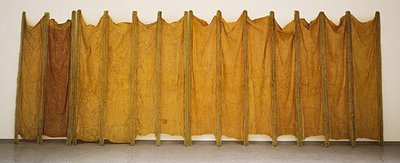
Above, and below, with our back to the Palermos, we’re looking at two lithographs by John McLaughlin. Being a lifelong East Coaster, Northeaster specifically, and New Yorker most specifically, I am not familiar with the oeuvre of this California-based painter. Minimalism is certainly his focus, though color does not seem to be a strong point.

Installation view of Blinky Palermo screenprints in foreground; Josef Albers screenprints on the far wall




Four prints by Blinky Palermo, 4 Prototypen, 1970, each 23 5/8 x 23 5/8 inches. Images from the MoMA exhibition website
.


Squares to more squares: Albers to Stella
.
To maintain that thrill a little longer, we move around to the Frank Stella screenprint, Double Gray Scramble, which alternates and and opposes tonalities of color and gray. The maze-like, but in fact concentric, progression pulls you deeply into its depths. This work, to me, is the abstract version of those Russian nesting dolls set into a hall of mirrors. Call me old fashioned, but I prefer this early work of Stella’s, before it exploded into dimensional frenzy. (I don’t dislike the new work, which I wrote about last year, I just like these flat geometries better.)
.

The Stella print is to the left of the doorway that takes you back into Gallery 1. To the right of the doorway is this celestial Sol Lewitt, below. The artist’s title is the dry Lines from Corners, Sides & The Center, To Points on a Grid, but it suggests to me nothing so much as a star map for a cubic universe. (I know, bad minimalist, reading poetry into the work.)

Sol Lewitt, Lines from Corners, Sides and the Center, to Points on a Grid, 1977, etching and aquatint, 34 5/8 x 34 13/16 inches

Sol Lewitt at left. Francois Morrellet, 8 Wefts 0 Degrees 90 Degrees, 1974, eight screenprints, each 23 5/8 x 23 5/8 inches
.
To the right of the Lewitt is a series of eight screenprints by Francois Morellett. The proportional order of the works seems a minimalist cliche to my eyes in 2008; still, there’s no denying the graphic power of these eight works as they move from white to black, maintaining the simplest geometric expression into a compressed infinity of blackness. Its placement after the Lewitt is graphically brilliant.
An enormous Richard Serra punctuates the dividing wall, and the gallery, with a muscular sweep of black oil stick and graphite. This work predates by about three decades the mighty steel sculptures shown at MoMA last year, but in this work you can certainly see where he was headed. And let me express awe for the framing job as well. How many of us have either the financial werewithall or the museum support to get a frame like this?

These last three images are meant to give you an overview of the exhibition:

Here we're standing with our backs to the Stella print so that we see Gallery 4 as it flows from Gallery 3


It has taken us four posts, but we have traveled a circle within a square, so our geometric journey has in fact been geometric itself.
.























